We’ve all heard the commercial: “Lucas Giolito, 2018, WORST pitcher in baseball.” We also all know the story from there. From 2019 through May 25, 2022, Giolito posted a 3.40 ERA, .281 wOBA against, and .210/.277/.374 slash line in 79 games. In that same span, he struck out 30.9% of batters and walked just 8.1%. He came into this season in a perfect position to continue to build his resume for a long-term contract.
However, in Giolito’s five starts since May 25, he’s been anything but the pitcher Sox fans have come to know him as over the past three seasons. Following another rough start against the Blue Jays this past week, Giolito’s ERA on the season has spiked all the way to 5.40. In his last 25.2 innings, Giolito has allowed 27 earned runs (9.47 ERA). Giolito has remained accountable and talked about some adjustments he needs to make, but no matter how you look at this, it’s an uncharacteristic five-game stretch for the right-hander.
So, what exactly has happened to Giolito? Everyone has their opinions, but can we use data to find the root causes? Let’s attempt to break it all down in hopes that a turnaround can begin today with the Angels.
Separating Facts from Fiction
Before breaking down some potential reasons for Giolito’s struggles, let’s make sure we understand what aren’t the reasons for his struggles first. This list was created based on some of the popular narratives among Sox fans in response to Giolito’s rough outing against the Blue Jays.
#1): “He hasn’t been the same since the ‘Sticky Stuff’ Ban”
This is easily the most popular theory among fans. This one is pretty straightforward for two reasons.
First, let’s look at Giolito’s average spin rate on his fastball by start in 2021:
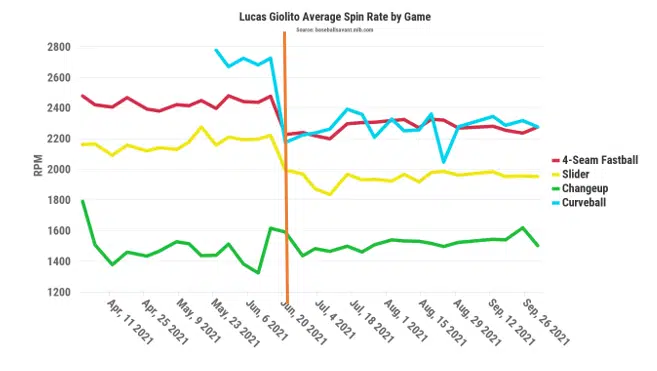
As you can probably guess, the orange line denotes Giolito’s first start post-ban (June 22, 2021). So, there’s a clear drop in spin rate on his fastball (~200 revolutions per minute) and his slider (~250 RPM), indicating that, yes, Giolito was likely using something, as most pitchers in the league were.
So, if that’s the case, then why is this in the “fiction” section? Well, here are his results in the first and second half of 2021:
| IP | ERA | FIP | wOBA | K% | BB% | |
| April – June 20, 2021 | 81.2 | 3.86 | 4.22 | .296 | 30.9% | 8.1% |
| June 22 – October 2021 | 97.0 | 3.25 | 3.43 | .282 | 25.3% | 6.5% |
Arguably, Lucas Giolito was better post-“sticky stuff” ban than before. His strikeout rate drop five percentage points, which isn’t an insignificant drop but does align with a pitcher trying to learn how to operate without whatever substance was used. At the same time, Giolito’s walk rate dropped, as did his ERA and FIP drastically from pre-ban performances. In fact, Giolito had a 2.65 ERA and .263 wOBA in the second half of 2021, clearly showing improvement over the first half of the 2021 season in which he had full access to his “sticky substance” of choice.
So, while the “sticky stuff” narrative is convenient on the surface, it doesn’t hold as much weight here as many would think.
#2) “Giolito was never that good in the first place”
Here is where Giolito ranks among qualified starters from 2019-2021:
fWAR: 7th (11.2)
ERA: 17th (3.47)
FIP: 15th (3.54)
Wins: T-16th (29)
K%: 6th (30.7%)
AVG: 7th (.206)
No matter what statistics you value, Lucas Giolito ranks in the top 17 in your statistic of choice. That’s typically considered to be a pretty good pitcher over the course of three seasons – certainly, one worthy of multiple top 10 Cy Young Award finishes.
The debate continues to be centered around if that qualifies Giolito as an “ace.” Depending on your definition, the above might be plenty for you to call Lucas Giolito an “ace,” when performing well of course. Others might consider him a solid #2 or #3 in the rotation. That said, that conversation isn’t necessarily important to this article.
The important point is that the idea that Lucas Giolito was never actually good is a baseless claim, and three years is a good sample size.
#3) “Giolito cannot pitch in day games”
This one seems to pop up a lot, though as with the other statements on this list, it’s pretty unfounded. Following his start against the Blue Jays last Wednesday afternoon, here were Giolito’s numbers on day and night games from 2019-2022:
| IP | ERA | FIP | wOBA | K% | BB% | |
| Day Games | 173.2 | 3.52 | 3.15 | .289 | 31.4% | 7.4% |
| Night Games | 317.1 | 3.83 | 4.07 | .295 | 29.5% | 8.6% |
He’s been better in his recent career in day games. The reason this narrative likely began was his blowup start in Boston on Patriots’ Day when Giolito essentially said he wasn’t a morning person, but in reality, was tipping his pitches.
Truth be told, all of these surface-level explanations were always too simple for the situation, but fit nicely in 280 characters on Twitter. Pitchers don’t simply struggle this badly for such things as above. But, now that we’ve discussed some of the popular narratives and why they don’t necessarily hold weight, let’s get down to some of the true root causes of Giolito’s struggles.
Fastball Spin and Velocity
Many fans throughout the years have noticed that Giolito’s fastball tends to be a tick or two lower to start the season – he will sit around 91-93 mph early in the season, adding velocity as his arm gets built up. You can see a trend such as this one in both 2020…
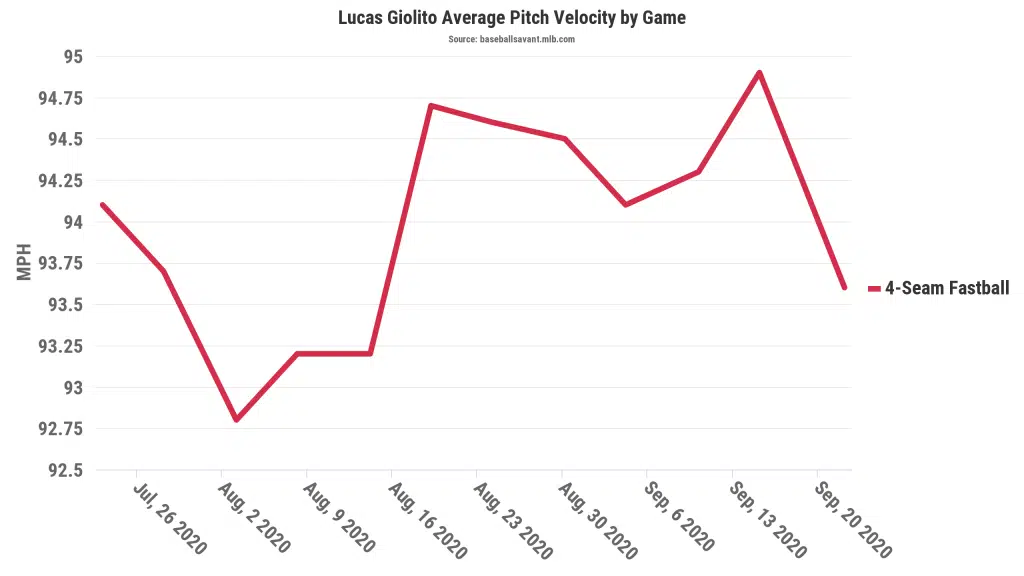
… and 2021
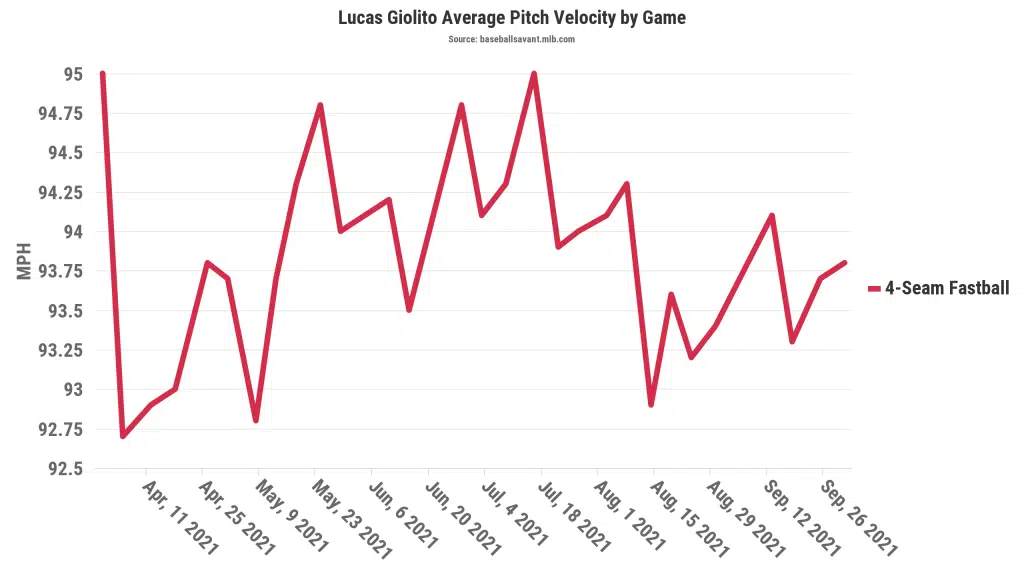
It’s not a perfect trend, as he did tire a bit towards the end of last season (pretty natural), but the velocity has clearly improved for Giolito as the season goes on in recent memory.
However, in 2022, we haven’t seen that trend yet, as he has averaged over 94 mph in just one start.
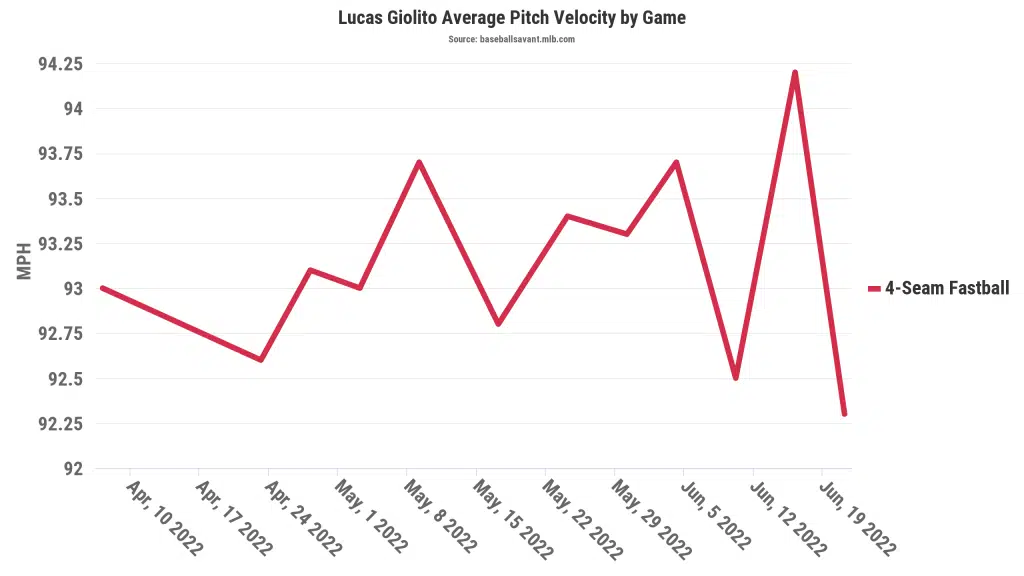
Velocity is only one part of the equation for Giolito, however. Remember that graph above showing the clear drop in RPMs for Giolito’s fastball following the “sticky stuff” ban? Here’s a continuation of that graph that includes 2022:
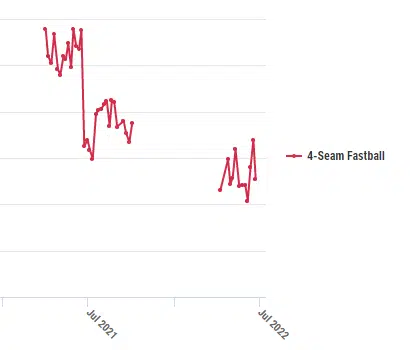
To put this into context: by September 2021, Giolito’s fastball was still averaging 2259 RPMs. In 2022, that number has dropped another 100 RPMs to approximately 2150 RPMs. In short, Giolito’s fastball is not only not the same one that he used in early 2021 – it’s also not the same one he had after the “sticky stuff” ban. Something is clearly up here.
We can also see this more concerning trend when you break it down from a pitch movement perspective. Here’s the vertical movement (“rise”) on Giolito’s fastball over the past three seasons:
| FB Vertical Movement (in.) | |
| 2020 | 12.5 |
| 2021 | 12.0 |
| 2022 | 12.9 |
One thing to note: for “inches of drop” on a fastball, pitchers aim for that number to be lower. Remember, “spin rate” is all about fighting gravity – so, the less the balls “drops,” the better.
In this case, Giolito’s fastball has flattened out by about an inch this year, as the average drop on his fastball has increased from 12 inches to nearly 13 inches. Essentially, he’s not getting as much “rise” out of his fastball as he did last year or even the year before in 2020, allowing hitters to more easily trust their eyes as to where the pitch will be crossing the plate.
In short, when your fastball is even just a tick slower, compounded by dropping a bit more than usual into the hitter’s bat path, it’s an obvious explanation for why hitters have a .509 SLG against his fastball so far this season. Even the smallest differences mean a lot – this is a game of inches after all.
What’s the fix here? In part, it’s mechanical, as Giolito has alluded to. He feels he’s getting a little bit of “cut” on his fastball, which appears to be true based on the data: the active spin (“good spin”) on his fastball has decreased a percentage point, and Giolito’s getting the lowest amount of horizontal movement on his fastball of his career – almost three inches fewer. He and Ethan Katz have even referenced his fastball movement specifically in a recent article with James Fegan:
“We’re working on his fastball,” pitching coach Ethan Katz said in Houston. “Some of the stuff we saw on film and in its behavior was not his norm. It was kind of dipping below his vertical (movement), and the cutting was not the same straight pitch that he has had. We really wanted to dig into that and make sure the vertical was there.”
– James Fegan’s Athletic Article
The good news is that this is clearly on Giolito and Katz’s radar. The bad news is that in-season adjustments are always difficult – it might get more difficult for fans to watch before it gets better for Giolito as it relates to his fastball.
Fastball/Changeup Combination and Location
One of the worst parts of a pitcher not having their fastball on any given day is the ramifications it has to all of their other pitches. One of the most important pitches in baseball – if not the most important – is a well-located fastball. Everything works well off of that. If your fastball isn’t sharp, hitters start to rule it out and sit on other pitches. If the velocity is down on their fastball, the speed differential between it and their offspeed pitches isn’t as large, allowing hitters to get away with guessing incorrectly more easily – if everything is the same speed, they’re more easily able to get their bat on it.
One of the keys for Giolito is the separation in velocity on his fastball and changeup. It’s part of what makes the changeup work so well. This season, Giolito’s average fastball velocity has dropped to 93.1 mph. At the same time, his average changeup velocity has risen just a bit to 81.7 mph.
| 2020 | +/- | 2021 | +/- | 2022 | +/- | |
| Fastball Velocity | 94 mph | -0.2 | 93.8 mph | -0.2 | 93.1 mph | -0.7 |
| Offspeed Velocity | 80.9 mph | -0.8 | 81.5 mph | +0.6 | 81.7 mph | +0.2 |
One mph less of differential may not seem that drastic, but in a game of inches and in a game of decisions being made in milliseconds, every mile per hour makes a difference. In addition, mistakes matter more, and for Giolito, he isn’t as pinpoint with his changeup location as he has been in the past. He’s both missing worse in the zone and out of the zone as compared to just last season, and he isn’t able to get away with as many mistakes this season.
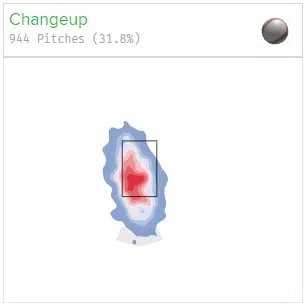
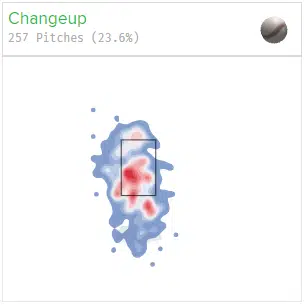
To see the effect of both fastball issues, speed differential, and slightly less command on the results, just look at the year-over-year numbers on Lucas Giolito’s changeup:
| AVG | SLG | wOBA | xwOBA | Whiff % | |
| 2021 | .218 | .383 | .281 | .245 | 35.4% |
| 2022 | .283 | .517 | .400 | .359 | 37.9% |
To be clear, there is very little difference in the shape of Giolito’s changeup, so this isn’t a “sticky stuff” issue. Plus, changeups are naturally a low-spin pitch. But this issue builds off what has been a very prevalent issue for Giolito: the fastball, mixed in with command. Truthfully, as we will come to conclude, a lot of Giolito’s struggles come back to the fastball.
Slider Shape
This has been one of the more interesting developments for Giolito throughout this season. While Giolito’s best secondary pitch since his 2019 resurgence has been his changeup, it’s his slider than has tended to generate more swings and misses from 2019-2022:
| Whiff % | 2019 | 2020 | 2021 | 2022 |
| Slider | 41.8% | 52.6% | 38.3% | 32.3% |
| Changeup | 41.2% | 41.4% | 35.4% | 37.9% |
This was until this season, however, and by a wide margin, Giolito’s struggling changeup is his best swing-and-miss pitch. Yet, it’s not generating results – though, neither is the slider, which hitters have a .563 SLG against.
Unlike his changeup, however, there is something drastically different about Giolito’s slider this year compared to years past. Take a look at the GIF below for the slider’s spin axis from 2020-2022. In particular, take a look at the distribution.
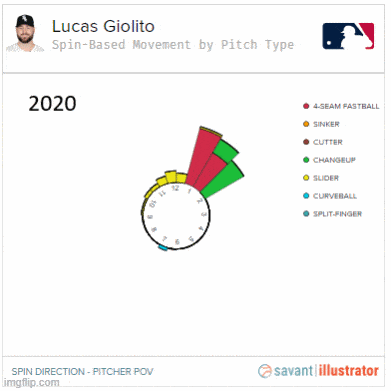
This isn’t a Physics class, so understanding what Spin Axis is isn’t necessarily important. However, what is important is that Lucas Giolito’s slider is spinning on a completely different axis than in previous seasons. Essentially, it moves differently and has a different shape to it. We can see this even further when we look at it from a vertical and horizontal movement perspective:
| Average MPH | Vertical Movement (in.) | vs. Average | Horizontal Movement (in.) | vs. Average | |
| 2020 | 84.9 | 34.2 | -2.4 | 3.5 | -1.1 |
| 2021 | 85.6 | 32.4 | -3.0 | 2.7 | -1.8 |
| 2022 | 84.7 | 37.0 | +0.4 | 4.0 | -1.7 |
Because the velocities for his slider in 2020 and 2022 are the most similar, those two are the easiest to compare. Giolito’s slider is now moving more both horizontally and vertically – but much more noticeably in the vertical direction. If you look at the 2022 slider below, it moves a lot more like how you would expect a curveball to move.
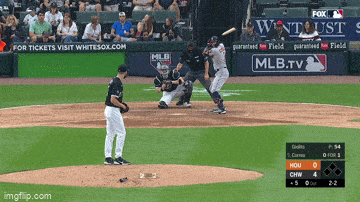
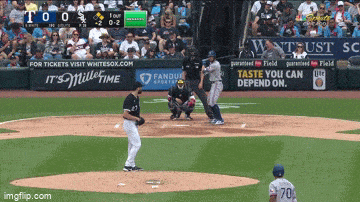
Now, this isn’t necessarily a good or bad thing on the surface. This is most likely a change Giolito and Ethan Katz were hoping to make to his slider. It’s a pretty drastic difference, so the assumption is that this is indeed intentional in an attempt to refine Giolito’s pitch arsenal and potentially work to incorporate his curveball back into his repertoire. But between the mechanical adjustments Giolito has mentioned, along with learning how to operate with a new pitch shape, it appears that some of Giolito’s struggles really do come right back to mechanics and trying to change quite a few things in-season. However, if this is an unintentional change in slider shape for Giolito, then it could be solely part of the mechanical issues he is working through. Either way, this is a pretty interesting find and isn’t something that Giolito nor Katz has mentioned too much throughout the offseason or regular season to this point.
COVID Aftermath/Other Possibilities?
This is the part that has the least amount of data to support it – in fact, any data really only serves as confirmation bias if anything. However, it’s worth noting that since Giolito has gone on the COVID IL on May 13, he definitely has not come back as the same pitcher.
Even more recently, he’s talked about a bad chest cold of sorts that started right after his Boston start in which he gave up six earned runs in just over four innings. He’s talked about this with Chris Rose recently, and he starts talking about it around the 3:15 mark in the interview.
You’ll notice this interview occurred on June 6th. At that point, Giolito had made a few starts since being placed on the COVID IL on May 13. He’s still dealing with some sort of sickness that feels relatively similar to the symptoms of COVID – namely, the chest cold turning into a cough. The point: there is a possibility that Giolito could be dealing with health issues that don’t involve his arm or legs.
We saw something similar happen to Yoan Moncada during the 2020 season – we all remember the images of Ricky Renteria fanning him down in the dugout after going first to home on a double in the gap, unable to catch his breath or feel 100% while moving around. Could this be a similar culprit? It’s really difficult to say. That being said, it would help explain some of Giolito’s struggles once he hits the 75-pitch mark – a milestone of struggle that is foreign to Giolito prior to this season:
| PA | AVG | OBP | SLG | OPS | |
| Pitches 1-25 | 70 | .344 | .429 | .672 | 1.101 |
| Pitches 26-50 | 72 | .197 | .319 | .328 | .647 |
| Pitches 51-75 | 73 | .224 | .260 | .418 | .678 |
| Pitches 75-100 | 60 | .421 | .433 | .737 | 1.170 |
| Pitches 101+ | 4 | .333 | .500 | 1.333 | 1.833 |
The general trend isn’t that uncommon for Giolito – his struggles early in games are well-documented. He gets settled in and, eventually, begins to give up hard contact again. However, this is occurring much earlier this season than in years past, causing many to wonder why exactly Giolito is tiring so quickly. For obvious reasons, the aftermath of COVID has become a common talking point.
COVID aftermath/some sort of sickness may only be part of Giolito’s struggles past 75 pitches. Perhaps this is part of the lingering effect of the lockout on Giolito – who didn’t have a full Spring Training with which to ramp up. It could also be that the extra muscle mass that Giolito visibly put on during the offseason – 20 pounds, according to Giolito himself – is something that Giolito is learning how to navigate. Back when Giolito first went on the IL this season with an abdominal injury, Frank Thomas expressed concern over the amount of weight Giolito gained during a segment of Unfiltered with David Kaplan. The conversation starts around 2:35.
All of this is speculation of course. It’s very hard to narrow anything down in this area because only Lucas Giolito knows the effects of COVID, sickness, weight gain, and a shortened Spring Training on his health and training regimen. However, given what we know, it’s not out of the realm of possibility to consider his general health might have something to do with his struggles.
Let’s review what we talked about here:
- To start, we walked through some common misconceptions about Giolito’s struggles. In short, no, the “sticky stuff” ban has nothing to do with this. Also, yes, Giolito has been a good pitcher for three years now, and no, he pitches better in day games than he does in night games in his career. These simplistic solutions have little validity here.
- It all starts with the fastball for Giolito – or any pitcher for that matter. This season, Giolito’s fastball velocity and spin rate have both decreased compared to the end of 2021. This has changed some of both the pitch shape and pitch movement, causing both Giolito and Ethan Katz to identify it as an area for needed improvement.
- Giolito’s fastball struggles have affected his other offspeed pitches as well. Without a strong fastball, hitters are more easily able to sit on and react to Giolito’s changeup and have done plenty of damage against it this season. Because of this, as Giolito struggles a bit with command of the pitch, he is less able to get away with mistakes.
- Giolito – intentionally or not – has changed the shape of his slider. Assuming this is an intentional change, it is likely something that Giolito is working on and refining throughout the season – that may take a bit of time. If it is unintentional, this likely goes a long with the mechanical changes he will need to make to improve his fastball shape.
- We know Giolito has battled with COVID and other illnesses recently. We also know he put on 20 pounds of muscle before this season. We’re seeing him become ineffective much earlier in the game than he has been throughout his career. We can only speculate, but all of this is worth discussing when it comes to general fatigue/performance.
For completeness, Giolito’s release point, extension, and general tunneling characteristics were studied to see if there might be any truth to the idea that he could be tipping his pitches. Long story short: nothing seems off.
There likely isn’t anyone who will tell you that Lucas Giolito has been anywhere near good through his last five starts – not even Giolito himself. However, at the end of the day, after three years of solid performances, Giolito has afforded himself the runway to be able to work through his struggles. He was just fine earlier this season, so while things may have been off, he does know how to pitch through the necessary changes he needs to make and feel comfortable making in-game.
Giolito has been no stranger to criticism throughout his career, nor is he a stranger to adversity. He’s a professional pitcher and borderline veteran at this point. It’s fair to say he’s earned the benefit of the doubt when it comes to figuring things out. There is no basis on which to call Giolito “washed” or “a bad pitcher,” so caution is advised when considering that stance. He will make the improvements necessary, no matter how long it takes.
Time is of the essence, though, for a team who could use one of its leaders to step up once again.
Follow us @SoxOn35th for more updates throughout the season!
Featured Image: Kamil Krzaczynski-USA TODAY Sports

What a great article – thank you for providing so much data!
This is an in-depth analysis on Giolito’s performance – thank you for the great write-up. On a macro level, this season is somewhat reminiscent of his 2018 campaign with the Sox when he ended the season with a WHIP of 1.48 and an ERA of 6.13.
Its easy to me, Giolito, like most of the Sox team, disappear when playing good talented teams. I think its pretty obvious given their record against over .500 teams last year, and from the looks of things, this year. This team overall has a heart issue. Hiring a past his prime (and then some) LaRussa was not going to help. The tony from 10 years ago would have been better, but that was 10 years ago. JR has to stop living in the past, which this org does a LOT of. Right now I just see a lot of aimless guys, and an apparent attitude of ‘this team is good; we’re toast’ kinda of look and response when facing top caliber teams (which the Sox were supposed to be, may I add).